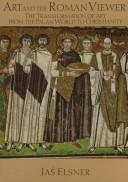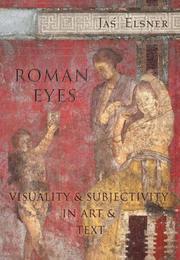| Listing 1 - 10 of 16 | << page >> |
Sort by
|
Book
ISBN: 8386956097 9788386956098 Year: 1996 Publisher: Kraków: Nakładem polskiej akademji umiejętności,
Abstract | Keywords | Export | Availability | Bookmark
 Loading...
Loading...Choose an application
- Reference Manager
- EndNote
- RefWorks (Direct export to RefWorks)
Greek language --- Literature --- Aesthetics, Roman. --- Latin literature

ISBN: 0521831652 Year: 2005 Publisher: Cambridge ; New York ; Madrid Cambridge University Press
Abstract | Keywords | Export | Availability | Bookmark
 Loading...
Loading...Choose an application
- Reference Manager
- EndNote
- RefWorks (Direct export to RefWorks)
Arguing that the scholarship on this topic has not appreciated Roman values in the visual arts, this book examines Roman strategies for the appropriation of the Greek visual culture. A knowledge of Roman values explains the entire range of visual appropriation in Roman art, which includes not only the phenomenon of copying, but also such manifestations as allusion, parody, and, most importantly, aemulatio, successful rivalry with one's models.
Aesthetics [Roman ] --- Esthetica [Romeinse ] --- Esthétique romain --- Aesthetics, Roman. --- Sculpture, Greek --- Sculpture, Roman --- Copying. --- Themes, motives. --- Sculpture [Roman ] --- Themes, motives --- Sculpture [Greek ] --- Copying --- Aesthetics, Roman --- Roman sculpture --- Roman aesthetics
Book
ISBN: 9781003038573 1003038573 1000988732 9780367478193 9781032553542 Year: 2024 Publisher: Abingdon ; New York : Routledge,
Abstract | Keywords | Export | Availability | Bookmark
 Loading...
Loading...Choose an application
- Reference Manager
- EndNote
- RefWorks (Direct export to RefWorks)
During the reign of Nero, Roman culture produced some of its most spectacular works of art and literature, and some of its strangest. This study explores these effects across textual and visual media in an integrated way. Weiss' analysis allows for appreciation of the shared strategies of composition, overlaps between literary and visual rhetoric, the role of context in shaping the reception of a work, and the authority of the reader/viewer to generate meaning. The volume offers an account of Roman visual-literary interactions in the mid-first century CE that considers these dynamics as informing broad cultural phenomena. The results reveal features pervasive in a literary and artistic culture invested in exploring the edges of expression. 'The Neronian Grotesque' is a fascinating study on the literary and artistic production in the Neronian period, and has wider implications for anyone working in the field of Roman cultural history and visual studies more broadly.
Aesthetics, Roman --- Art and literature --- Arts, Romanian --- Arts, Roman --- Aesthetics, Roman. --- Themes, motives. --- Rome --- History --- Création littéraire --- Création (esthétique) --- Grotesques (ornements)

ISBN: 0521453542 Year: 1995 Volume: *6 Publisher: Cambridge [England] New York Melbourne Cambridge University Press
Abstract | Keywords | Export | Availability | Bookmark
 Loading...
Loading...Choose an application
- Reference Manager
- EndNote
- RefWorks (Direct export to RefWorks)
Aesthetics [Roman ] --- Esthetica [Romeinse ] --- Esthétique romain --- Aesthetics, Roman --- Art, Early Christian --- Art, Roman --- Esthétique romaine --- Art paléochrétien --- Art romain --- Themes, motives --- Thèmes, motifs --- Esthétique romaine --- Art paléochrétien --- Thèmes, motifs --- Art [Roman ] --- Art [Early Christian ] --- Art, Early Christian - Themes, motives. --- Aesthetics, Roman.

ISBN: 9780691096773 0691096775 Year: 2007 Publisher: Princeton ; Oxford Princeton University Press
Abstract | Keywords | Export | Availability | Bookmark
 Loading...
Loading...Choose an application
- Reference Manager
- EndNote
- RefWorks (Direct export to RefWorks)
In 'Roman Eyes', Jas Elsner seeks to understand the multiple ways that art in ancient Rome formulated the very conditions for its own viewing, and as a result was complicit in the construction of subjectivity in the Roman Empire. Elsner draws upon a wide variety of visual material, from sculpture and wall paintings to coins and terra-cotta statuettes. He examines the different contexts in which images were used, from the religious to the voyeuristic, from the domestic to the subversive. He reads images alongside and against the rich literary tradition of the Greco-Roman world, including travel writing, prose fiction, satire, poetry, mythology, and pilgrimage accounts. The astonishing picture that emerges reveals the mindsets Romans had when they viewed art--their preoccupations and theories, their cultural biases and loosely held beliefs. 'Roman Eyes' is not a history of official public art--the monumental sculptures, arches, and buildings we typically associate with ancient Rome, and that tend to dominate the field. Rather, Elsner looks at smaller objects used or displayed in private settings and closed religious rituals, including tapestries, ivories, altars, jewelry, and even silverware. In many cases, he focuses on works of art that no longer exist, providing a rare window into the aesthetic and religious lives of the ancient Romans.
Art, Classical. --- Aesthetics, Roman. --- Visual perception. --- Art antique --- Esthétique romaine --- Perception visuelle --- Rome ancienne --- --Iconographie --- --Art --- --Littérature --- --Arts, Classical --- Aesthetics, Roman --- Visual Perception --- Arts, Classical. --- Esthétique romaine --- Arts, Classical --- Visual perception --- Optics, Psychological --- Vision --- Perception --- Visual discrimination --- Classical arts --- Roman aesthetics --- Psychological aspects --- Iconographie --- Art --- Littérature
Multi
ISBN: 9780521547925 9780521839280 0521839289 9780511780325 9780511932519 0511932510 051178032X 1282908138 9781282908130 1107209749 0511852363 9786612908132 0511931174 0511927339 0511924798 0511929838 052154792X Year: 2010 Volume: *18 Publisher: Cambridge Cambridge University Press
Abstract | Keywords | Export | Availability | Bookmark
 Loading...
Loading...Choose an application
- Reference Manager
- EndNote
- RefWorks (Direct export to RefWorks)
This anthology of philosophical texts by Greek and Roman authors brings together works from the late fifth century BC to the sixth century AD that comment on major aesthetic issues such as the perception of beauty and harmony in music and the visual arts, structure and style in literature, and aesthetic judgement. It includes important texts by Plato and Aristotle on the status and the role of the arts in society and in education, and Longinus' reflections on the sublime in literature, in addition to less well-known writings by Philodemus, Cicero, Seneca, Plotinus, Augustine and Proclus. Most of the texts have been newly translated for this volume, and some are available in English for the first time. A detailed introduction traces the development of classical aesthetics from its roots in Platonism and Aristotelianism to its ultimate form in late Antiquity.
Ancient history --- Aesthetics --- Aesthetics, Ancient. --- Arts --- Philosophy, Ancient. --- Esthétique ancienne --- Philosophie ancienne --- Philosophy. --- Philosophie --- 111.85 --- Philosophy & psychology Aesthetics --- Aesthetics, Ancient --- Aesthetics, Roman --- Esthétique ancienne --- Ancient philosophy --- Greek philosophy --- Philosophy, Greek --- Philosophy, Roman --- Roman philosophy --- Arts and Humanities --- Philosophy
Book
ISBN: 9783050059495 9789087281786 3050059494 3050062614 Year: 2012 Volume: *1 11 Publisher: Berlin Akademie Verlag
Abstract | Keywords | Export | Availability | Bookmark
 Loading...
Loading...Choose an application
- Reference Manager
- EndNote
- RefWorks (Direct export to RefWorks)
Many Romans wrote about the belief that an image - a sculpture or painting, as well as a verbal description or a personage on stage - is not a representation, but the image's prototype or that an image had particular aspects of life. A first group of authors explained these believes as incorrect observation or wrong mental processing by the beholder. Other authors pointed at the excellent craftsmanship of the maker of the image. A third group looked at the supernatural involvement of its prototype, often a god. Together these discourses on the animation of images bring us to what intellectuals from all over the Roman empire saw as reprehensible or acceptable in beholding images as works of art or as cult images. Moreover, these discourses touch upon ontological and epistemological problems. The barrier between life and death was explored and also the conditions to obtain knowledge from observation.
Classical Latin literature --- Art --- Philosophy and psychology of culture --- Sculpture, Roman. --- Art, Roman. --- Naturalism. --- Sculpture --- Aesthetics, Roman. --- Technique. --- Roman aesthetics --- Molding (Clay, plaster, etc.) --- Modeling --- Materialism --- Mechanism (Philosophy) --- Philosophy --- Positivism --- Science --- Roman art --- Classical antiquities --- Roman sculpture
Multi
ISBN: 9781108473897 9781108582513 9781108461702 Year: 2018 Publisher: Cambridge Cambridge University Press
Abstract | Keywords | Export | Availability | Bookmark
 Loading...
Loading...Choose an application
- Reference Manager
- EndNote
- RefWorks (Direct export to RefWorks)
Architecture, Roman. --- Sculpture, Roman. --- Building materials --- Sculpture materials --- Aesthetics, Roman. --- Material culture --- Recycling --- Spolia --- Building materials. Building technology --- Aesthetics of art --- Architecture --- Roman history --- sculpture [visual works] --- material culture [discipline] --- aesthetics --- adaptive reuse --- architecture [object genre] --- building materials
Book
ISBN: 1108676057 1108582516 1108644090 110847389X Year: 2018 Publisher: Cambridge : Cambridge University Press,
Abstract | Keywords | Export | Availability | Bookmark
 Loading...
Loading...Choose an application
- Reference Manager
- EndNote
- RefWorks (Direct export to RefWorks)
This book explores the spoliation of architectural and sculptural materials during the Roman empire. Examining a wide range of materials, including imperial portraits, statues associated with master craftsmen, architectural moldings and fixtures, tombs and sarcophagi, arches and gateways, it demonstrates that secondary intervention was common well before Late Antiquity, in fact, centuries earlier than has been previously acknowledged. The essays in this volume, written by a team of international experts, collectively argue that re-use was a natural feature of human manipulation of the physical environment, rather than a sign of social pressure. Re-use often reflected appreciation for the function, form, and design of the material culture of earlier eras. Political, social, religious, and economic factors also contributed to the practice. A comprehensive overview of spoliation and re-use, this volume examines the phenomenon in Rome and throughout the Mediterranean world.
Architecture, Roman. --- Sculpture materials --- Aesthetics, Roman. --- Building materials --- Material culture --- Sculpture, Roman. --- Roman sculpture --- Culture --- Folklore --- Technology --- Architectural materials --- Architecture --- Building --- Building supplies --- Buildings --- Construction materials --- Structural materials --- Materials --- Roman aesthetics --- Artists' materials --- Roman architecture --- Recycling --- Spolia
Book
ISBN: 1009207741 1009207768 1009207725 1009207776 Year: 2023 Publisher: Cambridge : Cambridge University Press,
Abstract | Keywords | Export | Availability | Bookmark
 Loading...
Loading...Choose an application
- Reference Manager
- EndNote
- RefWorks (Direct export to RefWorks)
Scholarship often treats the post-Roman art produced in central and north-western Europe as representative of the pagan identities of the new 'Germanic' rulers of the early medieval world. In this book, Matthias Friedrich offers a critical reevaluation of the ethnic and religious categories of art that still inform our understanding of early medieval art and archaeology. He scrutinises early medieval visual culture by combining archaeological approaches with art historical methods based on contemporary theory. Friedrich examines the transformation of Roman imperial images, together with the contemporary, highly ornamented material culture that is epitomized by 'animal art.' Through a rigorous analysis of a range of objects, he demonstrates how these pathways produced an aesthetic that promoted variety (varietas), a cross-cultural concept that bridged the various ethnic and religious identities of post-Roman Europe and the Mediterranean worlds.
Art and society --- Art, Medieval --- Art --- Aesthetics, Roman. --- Aesthetics, Medieval. --- Medieval aesthetics --- Roman aesthetics --- Art and sociology --- Society and art --- Sociology and art --- History --- Themes, motives. --- Historiography. --- Subjects --- Social aspects
| Listing 1 - 10 of 16 | << page >> |
Sort by
|

 Search
Search Feedback
Feedback About UniCat
About UniCat  Help
Help News
News